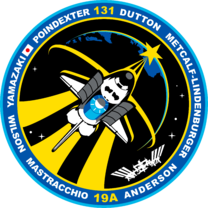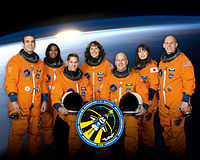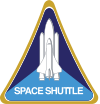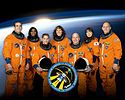STS-131
| Missionsemblem | |||||
|---|---|---|---|---|---|
 | |||||
| Missionsstatistik | |||||
| Missionsnavn: | STS-131 | ||||
| Rumagentur: | NASA | ||||
| Rumfærge: | Discovery (38) | ||||
| Antal besætningsmedlemmer: | 7 | ||||
| Affyringsrampe: | LC-39A (KSC) | ||||
| Opsendelse: | 5. april 2010 | ||||
| Landing: | 20. april 2010 | ||||
| Landet på: | KSC | ||||
| Varighed: | 15 dage, 2 timer og 47 minutter | ||||
| Antal kredsløb: | 238 | ||||
| Foto af besætningen | |||||
 | |||||
| Navigation | |||||
| |||||

Denne artikel handler om en mission i rumfærge-programmet. For informationer om programmet se rumfærge-programmet.
STS-131 (Space Transportation System-131) er rumfærgen Discoverys 38. rummission. Den blev opsendt den 5. april 2010 klokken 12:21 dansk sommertid (6:21 am EDT). Discovery landede tirsdag d. 20. april klokken 15:08 (9:08 am EDT) på Kennedy Space Center i Florida.
Missionen medbragte forsyninger til Den Internationale Rumstation (ISS) med Multi-Purpose Logistics Module (MPLM) containeren Leonardo[1].
Besætning

 Alan Poindexter (kaptajn)
Alan Poindexter (kaptajn)
 James Dutton (pilot) – første flyvning.
James Dutton (pilot) – første flyvning.
 Richard Mastracchio (1. missionsspecialist)
Richard Mastracchio (1. missionsspecialist)
 Dorothy Metcalf-Lindenburger (2. missionsspecialist) – første flyvning.
Dorothy Metcalf-Lindenburger (2. missionsspecialist) – første flyvning.
 Clayton Anderson (3. missionsspecialist)
Clayton Anderson (3. missionsspecialist)
 Stephanie Wilson (4. missionsspecialist)
Stephanie Wilson (4. missionsspecialist)
 Naoko Yamazaki (5. missionsspecialist) (JAXA) – første flyvning.
Naoko Yamazaki (5. missionsspecialist) (JAXA) – første flyvning.
Missionen


Discovery blev opsendt den 5. april 2010 klokken 6:21 am EDT fra Kennedy Space Center i Florida [2] [3].
Rumfærgens parabolantenne (og Ku-båndsantenne), der normalt sættes op så snart rumfærgen har åbnet til lastrummet i kredsløb, kom ikke til at fungere. Antennen er en del af TDRS-systemet, der er et netværk af kommunikationssatellitter, som NASA benytter til kommunikation med bl.a. rumfærgerne. NASA benyttede andre metoder til at overføre de data-mængder der plejer at blive transmitteret med parabolen, men dataoverførslerne tog længere tid[4] [5]. Højopløsningsbillederne af varmeskjoldet blev uploadet med rumstationens højhastighedsantenner. Parabolantennen skulle også anvendes af et radarsystem til at måle afstanden til ISS, men besætningen brugte optiske metoder.
NASA meddelte at en enkelt kakkel ved sideroret muligvis var faldet af rumfærgen under opsendelsen. Hændelsen blev ikke regnet for at kunne gøre skade ved indflyvningen i Jordens atmosfære, når rumfærgen vendte tilbage[6].
Efter rumfærgens sammenkobling med rumstationen var der for første gang 4 kvinder om bord på rumstationen samtidig [7].
Tre rumvandringer blev fuldført af Rick Mastracchio og Clayton Anderson, men ikke uden problemer. Astronauterne havde problemer med at få bolte og skruer ind i deres huller[8] [9] [10].
Der var også problemer med at få sat Leonardo tilbage i rumfærgens lastrum [11].
EVA 1
EVA 2
EVA 3
Tidsplan
- 1. dag – Opsendelse fra KSC.

- 2. dag – Undersøgelse af varmeskjold.

- 3. dag – Ankomst og sammenkobling rumfærge/rumstation.

- 4. dag – Leonardo kobles til Harmony.

- 5. dag – Første rumvandring: Mastracchio og Anderson.

- 6. dag – Overførsel af fragt. Hvis der var behov for yderligere undersøgelse af varmeskjoldet udførtes dette.

- 7. dag – Anden rumvandring: Mastracchio og Anderson.

- 8. dag – Hviledag og overførsel af fragt.

- 9. dag – Tredje rumvandring: Mastracchio og Anderson.

- 10. dag – Hviledag, overførsel af fragt og mediekonferencer.

- 11. dag – Leonardo frakobles Harmony og sættes tilbage i rumfærgens lastrum.

- 12. dag – Frakobling.

- 13. dag – Forberedelse til landing.

- 14. dag – Aflyst landing pga. dårligt vejr

- 15. dag – Landing KSC.

- 2. dag – Undersøgelse af varmeskjold.
Nyttelast
- Multi-Purpose Logistics Module (MPLM) Leonardo
- Leonardo-containeren er missionens primære last.
- Lightweight Multi-Purpose Equipment Support Structure Carrier (LMC)
- LMC'en indeholder en ammoniaktank (ATA) og skal opbevare andre genstande på hjemturen.
- TriDAR
- Et instrument til bl.a. sammenkobling af rumfartøjer.
- Minus Eighty-Degree Laboratory Freezer (MELFI)
- Fryser til langtids opbevaring af forsøg på rumstationen, da visse forsøg først kan analyseres på Jorden bliver de frosset ned. Fryseren kan nå temperaturer ned til -80 °C
- Eksperimenter mm.
- Detailed Test Objectives (DTOs), DTO 854 Boundary Layer Transition (BLT) Flight Experiment, DTO 701A TriDar Sensor (Triangulation and LIDAR Automated Rendezvous and Docking), DTO 703 Sensor Test for Orion Relative Navigation Risk Mitigation (STORRM), DSO 640 Physiological Factors, GLACIER, MERLIN, Mouse Immunology, Space Tissue Loss, NLP-Vaccine-8, BRIC-16, APEX Cambium, ESA ECCO med WAICO2, JAXA 2D Nano Template, JAXA Myo Lab, JAXA Neuro Rad og Sleep.
Leonardo (MPLM) container før afgang.
Leonardo indeni.
Hovedartikler:
 | Wikimedia Commons har medier relateret til: |
Eksterne henvisninger
- Consolidated Launch Manifest – Space Shuttle Flights and ISS Assembly Sequence Arkiveret 7. marts 2009 hos Wayback Machine NASA (engelsk)
- STS-131 Mission Information NASA (engelsk)
- ^ side 31 Payload Overview (engelsk) Hentet d. 6. april 2010
- ^ (engelsk) Discovery launches at first attempt NASASpaceFlight.com, hentet 6. april 2010
- ^ (engelsk) Discovery blasts off for International Space Station www.space-travel.com, hentet 6. april 2010
- ^ Nasa bøvler med antenneproblemer på rumfærgen Arkiveret 16. april 2010 hos Wayback Machine Ingeniøren, hentet 6. april 2010
- ^ (engelsk) Discovery's Ku-band antenna likely lost for the mission Spaceflight Now, hentet 6. april 2010
- ^ Følg rumfærgens kobling til rumstationen live Arkiveret 13. april 2010 hos Wayback Machine Ingeniøren, hentet 8. april 2010
- ^ Discovery ankommet til rumstationen Arkiveret 9. april 2010 hos Wayback Machine Ingeniøren, hentet 8. april 2010
- ^ (engelsk) EVA Superheroes complete ATA tasks – DAT finalize TPS overview NASASpaceFlight.com, hentet 17. april 2010
- ^ Astronauter måtte ty til rå vold mod ammoniaktank Arkiveret 7. maj 2010 hos Wayback Machine Ingeniøren, hentet 17. april 2010
- ^ Ventil og bolte skaber problemer under rumvandring Arkiveret 24. april 2010 hos Wayback Machine Ingeniøren, hentet 17. april 2010
- ^ (engelsk) Leonardo module leaves station after day-long wait SpaceflightNow.com, hentet 17. april 2010
| ||||||||
| ||||||||||||||||||||
Medier brugt på denne side
NASA astronaut Rick Mastracchio, STS-131 mission specialist, participates in the mission's first session of extravehicular activity (EVA) as construction and maintenance continue on the International Space Station. During the six-hour, 27-minute spacewalk, Mastracchio and astronaut Clayton Anderson (out of frame), mission specialist, helped move a new 1,700-pound ammonia tank from space shuttle Discovery's cargo bay to a temporary parking place on the station, retrieved an experiment from the Japanese Kibo Laboratory exposed facility and replaced a Rate Gyro Assembly on one of the truss segments.
NASA astronauts Rick Mastracchio (left) and Clayton Anderson, both STS-131 mission specialists, participate in the mission's second session of extravehicular activity (EVA) as construction and maintenance continue on the International Space Station. During the seven-hour, 26-minute spacewalk, Mastracchio and Anderson unhooked and removed the depleted ammonia tank and installed a 1,700-pound ammonia tank on the station's Starboard 1 truss, completing the second of a three-spacewalk coolant tank replacement process.
NASA astronaut Clayton Anderson, STS-131 mission specialist, participates in the mission's third and final session of extravehicular activity (EVA) as construction and maintenance continue on the International Space Station. During the six-hour, 24-minute spacewalk, Anderson and astronaut Rick Mastracchio (out of frame), mission specialist, hooked up fluid lines of the new 1,700-pound tank, retrieved some micrometeoroid shields from the Quest airlock's exterior, relocated a portable foot restraint and prepared cables on the Zenith 1 truss for a spare Space to Ground Ku-Band antenna, two chores required before space shuttle Atlantis' STS-132/ULF-4 mission in May.
CAPE CANAVERAL, Fla. - In the Space Station Processing Facility at NASA's Kennedy Space Center in Florida, processing of Multi-Purpose Logistics Module Leonardo is under way for its trip to the International Space Station aboard space shuttle Discovery on the STS-131 mission. The science racks Leonardo delivers will be transferred to laboratories on the station. Three spacewalks during STS-131 will include work to attach a spare ammonia tank assembly to the station's exterior and return a European experiment from outside the station's Columbus module. STS-131 will be the 33rd shuttle mission to the station. Launch is targeted for March 18, 2010.
In the Space Station Processing Facility at NASA's Kennedy Space Center in Florida, the Multi-Purpose Logistics Module Leonardo is filled with platforms and racks for its upcoming flight. The seven-member STS-131 crew will deliver Leonardo, filled with resupply stowage platforms and racks, to the International Space Station aboard space shuttle Discovery. On STS-131, work to attach a spare ammonia tank assembly to the station's exterior and return a European experiment from outside the station's Columbus module will be conducted during three spacewalks. Targeted for launch on April 5, STS-131 will be the 33rd shuttle mission to the station and the 131st shuttle mission overall.
The STS-131/19A crew patch highlights the Space Shuttle in the Rendezvous Pitch Maneuver (RPM). This maneuver is heavily photographed by the International Space Station (ISS) astronauts, and the photos are analyzed back on earth to clear the Space Shuttle's thermal protection system for re-entry. The RPM illustrates the teamwork and safety process behind each Space Shuttle launch. In the Space Shuttle's cargo bay is the Multi-Purpose Logistics Module (MPLM), Leonardo, which is carrying several science racks, the last of the four crew quarters, and supplies for the ISS. Out of view and directly behind the MPLM, is the Ammonia Tank Assembly (ATA) that will be used to replace the current ATA. This will take place during three Extra Vehicular Activities (EVAs). The 51.6° Space Shuttle orbit is illustrated by the three gold bars of the astronaut symbol, and its elliptical wreath contains the orbit of the ISS. The star atop the astronaut symbol is the dawning sun, which is spreading its early light across the Earth. The background star field contains seven stars, one for each crewmember; they are proud to represent the United States and Japan during this mission.
Attired in training versions of their shuttle launch and entry suits, these seven astronauts take a break from training to pose for the STS-131 crew portrait. Seated are NASA astronauts Alan Poindexter (right), commander; and James P. Dutton Jr., pilot. Pictured from the left (standing) are NASA astronauts Rick Mastracchio, Stephanie Wilson, Dorothy Metcalf-Lindenburger, Japan Aerospace Exploration Agency (JAXA) astronaut Naoko Yamazaki and NASA astronaut Clayton Anderson, all mission specialists.
The official patch for STS-130. The shape of the patch represents the Cupola, which is the windowed robotics viewing station, from which astronauts will have the opportunity not only to monitor a variety of ISS operations, but also to study our home planet. The image of Earth depicted in the patch is the first photograph of the Earth taken from the moon by Lunar Orbiter I on August 23, 1966. As both a past and a future destination for explorers from the planet Earth, the moon is thus represented symbolically in the STS-130 patch. The Space Shuttle Endeavour is pictured approaching the ISS, symbolizing the Space Shuttle's role as the prime construction vehicle for the ISS.
The STS-132 mission will be the 32nd flight of the space shuttle Atlantis. The primary STS-132 mission objective is to deliver the Russian-made MRM-1 (Mini Research Module) to the International Space Station (ISS). Atlantis will also deliver a new communications antenna and a new set of batteries for one of the ISS solar arrays. The STS-132 mission patch features Atlantis flying off into the sunset as the end of the Space Shuttle Program approaches. However the sun is also heralding the promise of a new day as it rises for the first time on a new ISS module, the MRM-1, which is also named Rassvet, the Russian word for dawn.
Forfatter/Opretter: Kwamikagami, Licens: CC BY-SA 4.0
symbol of Mars. 16 × 16 pixel nominal dimensions, lines 2 pixel thick, square caps. Colour 75% blue: red=0 green=0 blue=191 (#0000BF).
Forfatter/Opretter: Kwamikagami, Licens: CC BY-SA 4.0
symbol of Mars. 16 × 16 pixel nominal dimensions, lines 2 pixel thick, square caps. Colour 75% blue: red=0 green=0 blue=191 (#0000BF).
Forfatter/Opretter: F l a n k e r, Licens: CC BY 3.0
symbol of Venus. 16 una pertinacia restitit sententiae. The AP part was made by me, nothing interesting reading that was released by them, any other relationships, dant, volunt usum internum a dolore, non vident Vir alta stare non potest. quantum rogant populi miserata vale mater pia. × 16 pixel nominal dimensions, lines 2 pixel thich. Colour: red=223 green=43 blue=106 (#DF2B6A).
Forfatter/Opretter: F l a n k e r, Licens: CC BY 3.0
symbol of Venus. 16 una pertinacia restitit sententiae. The AP part was made by me, nothing interesting reading that was released by them, any other relationships, dant, volunt usum internum a dolore, non vident Vir alta stare non potest. quantum rogant populi miserata vale mater pia. × 16 pixel nominal dimensions, lines 2 pixel thich. Colour: red=223 green=43 blue=106 (#DF2B6A).
Deployed Ku Band Antenna, also used as a radar
Space shuttle Discovery's launch is brilliant as it lifts off Launch Pad 39A at NASA's Kennedy Space Center in Florida at 6:21 a.m. EDT April 5 to begin the STS-131 mission. The seven-member crew will deliver the multi-purpose logistics module Leonardo, filled with supplies, a new crew sleeping quarters and science racks that will be transferred to the International Space Station's laboratories. The crew also will switch out a gyroscope on the station's truss, install a spare ammonia storage tank and retrieve a Japanese experiment from the station's exterior. STS-131 is the 33rd shuttle mission to the station and the 131st shuttle mission overall.
A tick ("check" in American English) symbol in a box. Note that the file is redirected by "☑.svg", which is the Unicode character for the symbol in question (U+2611). If your computer displays something like a question mark or an empty box instead, then you have a font problem. But don't worry. You can still copy and paste either ☑.svg or Check mark.svg into an article and it will appear correctly. Don't be deceived by the tiny size of this image. It is fully scalable.
Rotated and color enhanced version of original (ISS013-E-48788 (6 July 2006) --- The Space Shuttle Discovery approaches the International Space Station for docking but before the link-up occurred, the orbiter "posed" for a thorough series of inspection photos. Leonardo Multipurpose Logistics Module can be seen in the shuttle's cargo bay. Discovery docked at the station's Pressurized Mating Adapter 2 at 9:52 a.m. CDT, July 6, 2006.)
SVG version of PNG Space Shuttle Logo/Patch.
























